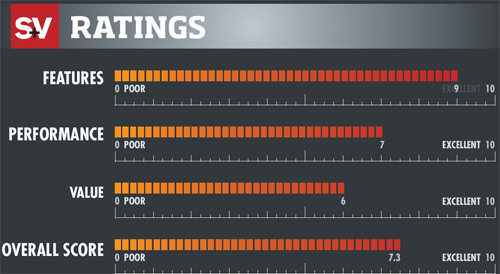Samsung UN46C8000 3D LED HDTV and BD-C6900 3D Blu-ray Player Page 3

BOTTOM LINE
Chances are you’ve heard naysayers, including prominent film critics like Roger Ebert, dismiss 3D as a fad destined to fade in the wake of Avatar’s long tail. I do not count myself among them. Movies, TV shows, games, and digital photos, in my estimation, can benefit from an extra dimension — that is, if the presentation is done right.
Samsung’s UN46C8000 3D LED HDTV and BD-C6900 Blu-ray Disc player do lots of things right. For the TV, that means displaying images with accurate colors, punchy contrast, and detailed shadows. Many aspects of its 3D presentation were also impressive, although the ghost images that I observed tended to detract from my sense of immersion in the 3D world. The UN46C8000 is the first and only 3D set I’ve had my hands on, however, so I have nothing to compare it to outside of my experience in theaters, which has so far been free of onscreen ghosts. Until I get a similar TV in to test, those ghosts will continue to haunt me. But if you’re looking for a LED-lit LCD TV that provides solid 2D performance, and if you don’t mind living dangerously by springing for first-generation 3D technology as well, Samsung’s 8000 Series TV pretty much defines the bleeding edge.

TEST BENCH
Precalibration measurements were made with the Samsung UN46C- 8000’s Movie picture mode and Warm 2 color-temperature presets selected. At those settings, grayscale tracking measured ±158 K of the 6,500-K standard from 20 to 100 IRE — excellent performance. Adjustments made to the set’s 10-point White Balance menu helped to even out some nonlinearity at the low end of its grayscale, although the menu’s settings had no effect with higherbrightness (60 IRE and above) test patterns.
Separate picture adjustments are a must for watching 3D programs: The brightness drops around 70% when viewing images in 3D mode, and color shifts need to be compensated for. The TV’s color decoding was essentially perfect, and its primary and secondary color points closely tracked the SMPTE HD color specification. Gamma at the 0 default setting was 2.3, which is very close to the 2.2 target.
Overscan — the amount of picture area hidden behind the edges of the screen — measured 0% for highdefinition signals with the Screen Fit mode selected and 3% in 16:9 mode. The TV displayed 1080i- and 720p format high-def as well as standard def test patterns at full resolution via both its HDMI and component-video inputs. With its judder/blur-reduction modes active, more than 1,000 lines were visible on motion-resolution tests. These imparted a “video look” to fi lm-based programs, although the level of smoothing varied by mode, with Smooth being the most aggressive, and Custom the least when its judder slider was pushed to the lowest setting.
- Log in or register to post comments




















































